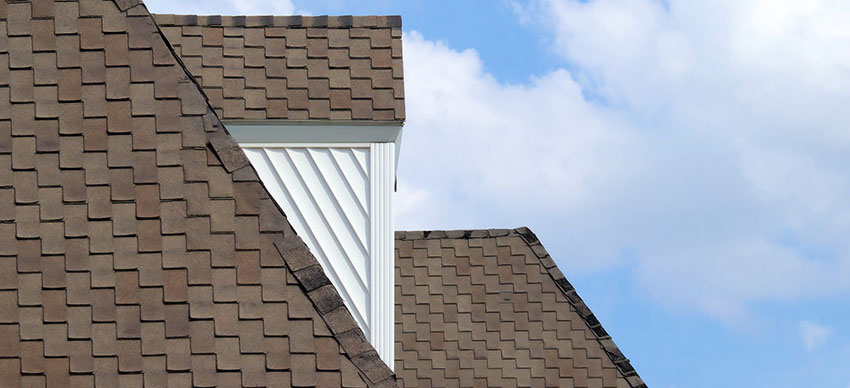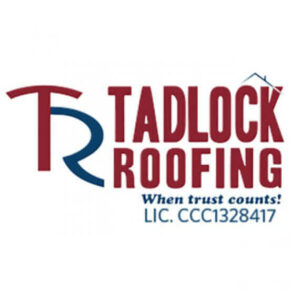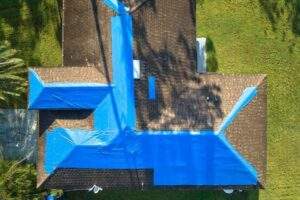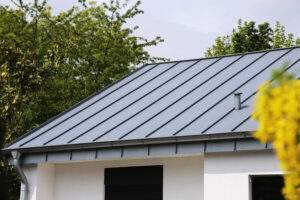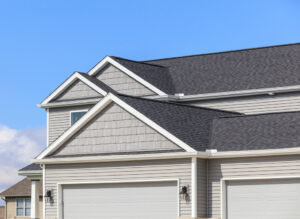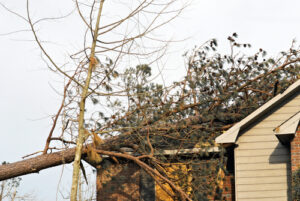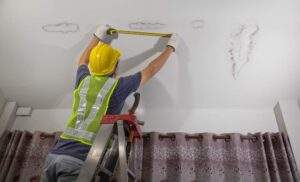Your roof is one of the most important investments you’ll make for your home, but its longevity depends on several key factors. A roof’s life expectancy can vary depending on the roofing material used, the quality of installation, and local climate conditions.
But for starters, most roofs can last anywhere from 15 to 50 years.
Asphalt shingles typically last 15-20 years, while metal roofs can offer longer lifespans of 40-70 years. Tile and slate roofs may even exceed 50 years with proper maintenance.
Understanding the factors that influence the roof’s lifespan can help you make informed decisions about maintenance and roof replacement. Weather conditions, ventilation, and regular inspections all make a big difference in how long your roof will hold up.
Key Takeaways: What You Should Know
- Different roofing materials have varying lifespans.
- Asphalt shingles usually last around 15-20 years. Metal roofs can last 40-70 years. Tile and slate roofs might last up to 100 years or more.
- Regular roof maintenance can extend the lifespan of your roof. This includes cleaning gutters, inspecting for damage, and fixing small issues promptly.
- Climate plays a significant role. Exterior roof elements in areas with extreme weather conditions may have shorter lifespans due to wear and tear.
- Roofing warranties vary by manufacturer and material. Always check the warranty details to understand what’s covered.
- Proper installation is critical. Even the best materials won’t last if the roof isn’t installed correctly. Always hire a reputable contractor.
- Signs of aging include curling shingles, missing granules, roof leaks, and visible wear. Addressing these issues early can prevent bigger problems.
- Budgeting for a new roof is important. Costs can range depending on materials and labor. Keep in mind that a quality roof can be a good investment.
- Environmental factors matter. For example, roofs in coastal areas may suffer from salt corrosion, while those in wooded areas might deal with moss growth.
Knowing these key points helps homeowners make informed decisions about their roofs.
What Factors Determine How Long A Roof Should Last?
The lifespan of a roof can vary widely based on several key factors. These include the type of roofing materials used, the climate and environmental conditions, and the quality of installation.
Types Of Roofing Materials And Their Lifespan
Different roofing materials come with different life expectancies.
| Material | Description | Lifespan |
| Asphalt Shingle Roofs | One of the most common and affordable roofing materials. Easy to install and repair. | 15-20 years |
| Metal Roofs | Highly durable and resistant to extreme weather. Offers a modern aesthetic and longevity. | 40-70 years |
| Clay Tiles | Extremely durable and can withstand harsh weather. Ideal for Mediterranean or Spanish-style homes. | 50-100 years |
| Slate Roofs | Known for its exceptional longevity and classic appearance. Great for historic or luxury homes. | 75-200 years |
| Wood Roofs | Offers a natural look and is environmentally friendly. Requires proper care for longevity. | 25-30 years |
Climate And Environmental Conditions
Weather plays a significant role in determining the longevity of a roof. Depending on where you live, different environmental factors can impact how long your roof lasts. Here are some key climate-related issues that can affect your roof:
Frequent Hail
- Constant hailstorms can cause gradual damage to your roof.
- Hail can chip, dent, or crack roofing materials, weakening their protective barrier over time.
- Roofs in hail-prone areas may need more frequent inspections and repairs.
Extreme Heat
- Excessive heat, especially in hot climates, can cause asphalt shingles to crack, curl, or warp.
- Prolonged exposure to UV rays can also cause materials to dry out and degrade faster, shortening the roof’s life expectancy.
Cold Climates
- In cold regions, materials expand and contract with temperature changes, which can lead to cracks or structural issues.
- Ice dams, caused by melting snow refreezing at the roof’s edges, can cause leaks or severe damage if not properly managed.
Humid Areas
- High humidity can encourage the growth of mold, algae, and moss, which can weaken the roofing material and reduce durability.
- Moisture can seep into small cracks, leading to rot and water damage over time.
- Regular cleaning and installing algae-resistant shingles can help prevent moisture-related problems.
By understanding how different climates affect roofing materials, homeowners can take preventive measures to extend the life of their roofs and minimize weather-related damage.
Installation Quality And Its Effect On Roof Durability
How well a roof is installed can greatly influence its lifespan. If it’s not installed properly, it might end up leaking, sagging, or premature wear. That’s why it’s important to hire experienced and qualified roofing contractors for roof installation.
Proper ventilation, correct alignment of shingles, and secure fastening of materials are all important steps that can extend the life of a roof.
Remember, quality workmanship makes a big difference.
Extending The Life Of Your Roof
Make sure to take care of your roof in order to keep it in good shape and make it last longer. Here are a few ways to get started:
Annual Inspections
Annual inspections are crucial for identifying potential problems early. Have a professional roofing contractor check for these issues.
| Inspection Task | What to Look For | Importance |
| Loose or Missing Shingles | Cracked, curled, or missing shingles, granule loss | Prevents water penetration and roof degradation |
| Leaks or Water Damage | Water stains on ceilings, moisture or mold in attic | Early detection prevents structural damage |
| Structural Integrity | Sagging roof areas, damaged roof supports or rafters | Identifies potential collapses or structural issues |
| Gutter Condition | Debris buildup, clogged downspouts, proper water flow | Ensures proper drainage and avoids water backup |
| Flashing Around Roof Openings | Rust, cracks, looseness, improper seals around chimneys, vents, skylights | Prevents water from entering through weak points |
| Mold, Algae, or Rot | Dark stains, growths on shingles, especially in areas with moisture buildup | Keeps roof materials in good condition |
| Roof Valleys | Debris buildup, damaged or misaligned shingles in roof valleys | Valleys are prone to leaks due to water flow |
| Post-Severe Weather Check | Hail dents, wind damage, cracks or wear after heavy rain or storms | Prevents small damages from worsening |
Getting ahead of these issues can really prevent major damage in the long run. And more importantly, finding and fixing small problems early on can save you a lot of money and make your roof last longer.
Regular Gutter Cleaning And Maintenance
Gutters are essential for keeping your roof in top shape. When gutters get clogged, water can build up and cause all sorts of problems like mold, rot, and even structural damage.
Here’s a quick step-by-step guide to gutter cleaning and maintenance:
- Clean gutters at least twice a year – Schedule cleanings in the spring and fall to remove accumulated debris.
- Use a sturdy ladder – Ensure your ladder is stable and positioned safely before starting.
- Remove debris by hand – Clear leaves, twigs, and other debris from the gutters by hand.
- Flush with a hose – Use a hose to wash out smaller particles and ensure water flows properly.
- Install gutter guards – Consider adding gutter guards to reduce the frequency of cleaning.
- Check for leaks or damage – Inspect for leaks or damages, and make necessary repairs to keep water flowing away from your roof.
Trim Overhanging Branches
You have to watch out for those overhanging branches.
During storms, branches can break and fall on to the roof, causing damage. Regularly trimming these branches can prevent such incidents.
Trees near your roof can also drop leaves, pine needles, and other debris onto the roof, leading to moisture buildup and potential rot. Keeping branches a safe distance away mitigates this risk.
And more importantly, trimming should be done by professionals if the branches are large or high up. They have the right tools and skills to do the job safely, ensuring your roof remains untouched and in great condition.
Schedule a Professional Roof Inspection
Your roof’s lifespan depends on factors like material, climate, and maintenance. Regular inspections and prompt roof repairs can help prevent serious issues like leaks and missing shingles. If your roof shows signs of damage or has been through severe weather, it’s time to act.
Tadlock Roofing is here to provide expert inspections, repairs, and replacements. For trusted roofing solutions, call us toll-free at 855-694-7376 or fill out our online form to get started.


